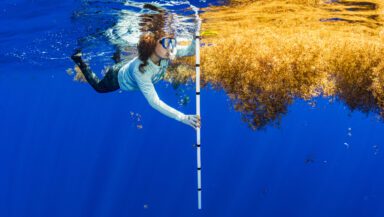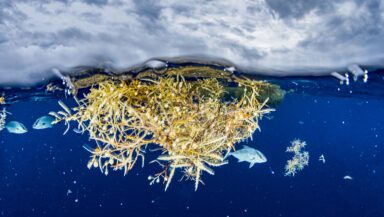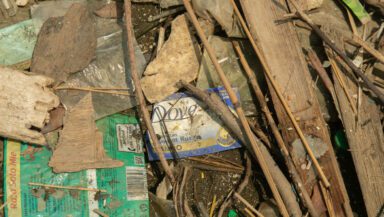Greenpeace reveals the plastic choking the ‘golden floating rainforest’ of the Sargasso Sea
- Voyage kicks off campaign to create world’s first high seas ocean sanctuary
- Campaigners retrieve over 300 pieces of plastic in just 30 minutes
- Photos and video available here
London, 7 May 2024 – Campaigners from Greenpeace UK have retrieved hundreds of pieces of plastic from clusters of seaweed floating in the Sargasso Sea in the Atlantic Ocean. They spent the last five days on board the Arctic Sunrise crossing the sea to launch a campaign to create a global network of marine sanctuaries under the Global Ocean Treaty.
The ship crew made an unplanned stop to look inside a patch of sargassum seaweed – the golden algae that forms gigantic floating mats and gives the Sargasso Sea its name. Although this was a comparatively small mat, they retrieved more than 300 pieces of plastic in just 30 minutes including bottle caps, disposable lighters, buoys, shoes, children’s toys and dozens of smaller scraps in the process of breaking down into microplastics.
Briony Venn, oceans campaigner for Greenpeace UK, said: “As soon as the sargassum came into view from the ship’s bridge, we saw large pieces of plastic debris tangled inside it. On closer inspection, every clump of seaweed contained a panoply of plastic pollution, from bottle caps to disposable cutlery.
“Plastic is just one of the threats facing the Sargasso along with industrial fishing, increased shipping and climate change. The UK has an opportunity to help protect this golden floating rainforest by ratifying the Global Ocean Treaty as soon as possible, and by working with other governments to champion the Sargasso Sea as the world’s first high seas ocean sanctuary under the Treaty.”
The sargassum species of seaweed is unique to the Sargasso Sea where it provides a vital habitat for 10 species of crab, fish, shrimp and other creatures that are found nowhere else. It also provides a nursery for baby sea turtles and a vital source of food for seabirds on their epic migrations across the Atlantic Ocean.
The crew also stopped to pull a metre-wide tangle of ‘ghost gear’ – discarded rope and fishing gear – from the water where it could have snarled sea turtles, seabirds and other marine animals.
This first leg of the voyage has helped to document the vast array of animals living in the Sargasso. The crew recorded humpback and pilot whales, dolphins and a wide variety of fish and seabirds. At one point, a pod of at least 20 pilot whales surrounded the ship, and several humpback whales accompanied the Arctic Sunrise into Bermuda.
The crew also used a hydrophone – an underwater microphone – and DNA sampling techniques to provide insights into the distribution and migration patterns of whales, dolphins and other marine animals. Two seabird conservationists from Bermuda joined the voyage and recorded more than 10 species including some frequent visitors to the UK such as Manx and Great Shearwaters, Leach’s Petrels and Arctic Skuas.
Industrial fishing fleets pose a major threat to marine ecosystems like this because they drag longlines through the sea which inadvertently hook marine mammals, turtles, seabirds and sharks. Increased shipping and the prospect of deep sea mining also cast a shadow over the future of this ecosystem.
Since most of the Sargasso Sea lies in the high seas, outside national borders, tools for restricting human activity here have been extremely limited. The Global Ocean Treaty agreed in March last year makes it possible for governments to create sanctuaries on the high seas – like national parks at sea – where marine life can recover and thrive.
Greenpeace UK is calling on the UK government to ratify this Treaty into national law before the General Election, and to work with other governments in the region to propose the Sargasso Sea as the world’s first high seas sanctuary under the Treaty. This, alongside a Global Plastics Treaty that cuts plastic production and ends single-use plastic, would go a long way towards protecting the sea.
ENDS
To arrange an interview with a Greenpeace spokesperson on the Arctic Sunrise, contact Alex Sedgwick in the Greenpeace press office: Alexandra.Sedgwick@greenpeace.org / +44 (0) 7973 873 155
The onboard press officer is Kai Tabacek: Kai.tabacek@greenpeace.org / +44 (0)7970 030 019
Greenpeace International press hotline (24/7): +31 (0)20 718 2470 / pressdesk.int@greenpeace.org
Notes to editors:
Download high-res images and video of the Arctic Sunrise in the Sargasso Sea, including drone footage here: https://media.greenpeace.org/collection/27MZIFJBVUMOZ
The Arctic Sunrise arrived in the British Overseas Territory of Bermuda on Sunday 5 May and will be based in Hamilton until Monday 20 May 2024. Greenpeace UK will be holding a variety of events to engage with the Bermudian public, politicians and local groups including an open boat, tours of the ship and a workshop on ocean sanctuaries.
Plastic debris appears in every ocean of the world. Researchers have found plastic in the stomachs of 44% of all seabird species, 22% of cetacean species, and in all sea turtle species. Among seabirds, petrels and shearwaters are particularly vulnerable to plastics.
The birds seen on this transit include: Audobon Shearwater, Manx Shearwater, Great Shearwater, White-tailed Tropicbird, Leach’s Storm Petrel, Wilson’s Storm Petrel, Pomarine Skua, Arctic Skua, Sooty Tern, Sabine’s Gull, Barn Swallow and Brown Booby. Other marine life included humpback and pilot whales, dolphins, dolphin fish, trigger fish, Portuguese man o’ war, Imperial Blackfish and sargassum swimming crabs.



